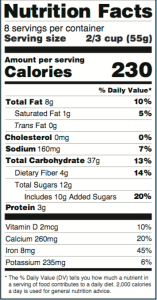How To Read Food Labels For Better Health
Let’s discuss the Nutrition Facts label and the Ingredient that is found on all packaged foods. Recently the FDA, the Food and Drug Administration, updated the Nutrition Facts based on current research and the public’s desire for more and better information. These food labels hadn’t been updated in over 20 years. The new labels are easier to read and provide more useful information.
By reading, and understanding the labels on the foods you buy and eat, you can better take control of your health and weight. There are so many choices today, and by picking a healthier version, of peanut butter, for example, you can have an impact on your long-term health.
How To Read the Nutrition Facts:
Servings per Container
At the top of the facts the number of servings per container is listed.
Below the total number of servings is the Serving Size This is an important measurement, as the remainder of the information on the fact s is based on the serving size. Often times we eat more than one serving size.
Calories
The next number is the calorie count for one serving. Again, if you consume more than one serving, you need to double or even triple this number. Calorie is a measurement of energy supplied by food. The correct number of calories, per day, varies based on your height, weight age, sex, and physical activity level. Check the Rolling Strong application under Nutrition, Nutrition Profile, to see your daily calorie intake recommendation.
% Daily Value
The % Daily Value is based on a 2,000 calorie diet for reference. The macro nutrient breakdown for Fat, Carbohydrate and Protein, is provided. Your daily calorie recommendation may be different. The %Daily is listed for Total Fat, Saturated Fat, and Trans Fat. Excess consumption of Saturated Fat can lead to a variety of health issues including heart disease and obesity. Work to keep your saturated fat intake below the recommended limits to improve your health. Trans Fat is an artificial fat that is harmful to your health and should not be consumed at any level. Manufacturers have removed most trans fat from foods, based on the science against it and consumer demand. In general, 5% of DV or less of a nutrient, is considered low. 20% of DV or higher of a nutrient is considered high. Keep an eye on Saturated and Trans Fat and work to reduce your intake of both.
A few highlights from the % Daily Value
Sodium is another important consideration that is listed on the Nutrition Facts. The American Heart Association recommends an upper limit of 2300 milligrams per day of sodium, with an ideal consumption at 1500 milligrams or less. For those with high blood pressure, it is especially important to reduce sodium to safe levels. Excess sodium is found in many processed foods, like package meats, snack foods, sauces, and frozen meals. Reading the Nutrition Facts is an important way to control the amount of sodium you consume.
Dietary Fiber is a key to helping prevent high cholesterol, help control blood sugar, and fight heart disease. Fiber also helps keep you regular, moving things through your digestive system. Fiber helps make you feel full, so can be a great tool for weight loss. For a 2,000 calorie diet, 25 grams of daily fiber is recommended. Most Americans don’t eat nearly enough fiber-which is plentiful in whole grains, fruits and vegetables, nuts and seeds and beans. Check the fiber content of the cereals, breads, pasta, and rice that your buy.
Added sugar is just that, the amount of additional sugar, not natural that is added to a food. This information was broken out on the new label so consumers can more easily make good decisions about how much sugar they are eating. Too much sugar is linked with obesity, diabetes, and a variety of other health conditions. According the American Heart Association, added sugar should be limited to 9 teaspoons for men (36 grams and 150 calories and 6 teaspoons for women (25 grams and 100 calories).
Vitamin D, Calcium, Iron and Potassium are listed at the bottom of the Nutrition Facts. These important vitamins and minerals are often deficient in American diets so are broken out for consumers.
 It is also critical to read the list of ingredients for each food item. Ingredients are listed in descending order, so the first ingredient makes up most of that food. Look for foods that have fewer ingredients. The long list of ingredients usually includes chemicals and preservatives. Choose a peanut butter that has few ingredients, all of which you understand-like roasted peanuts and salt.
It is also critical to read the list of ingredients for each food item. Ingredients are listed in descending order, so the first ingredient makes up most of that food. Look for foods that have fewer ingredients. The long list of ingredients usually includes chemicals and preservatives. Choose a peanut butter that has few ingredients, all of which you understand-like roasted peanuts and salt.
Reading labels can be a key to optimal health and weight loss success as your choose foods lower in saturated fat, calories, sodium, and added sugar. Add more fiber to your diet by noticing how much fiber each slice of bread contains.
by Christy Coughlin

